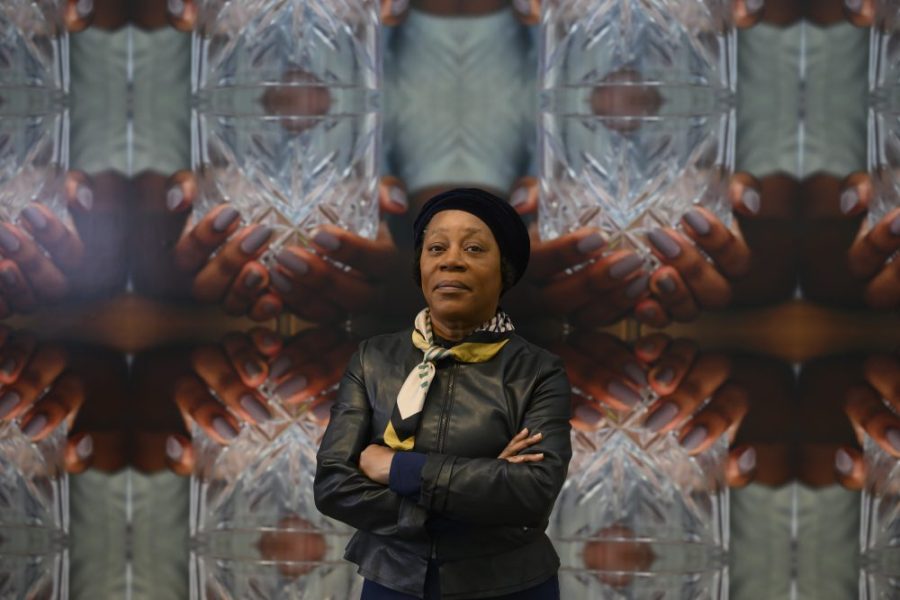‘I want you to imagine that you are a huge bell,’ suggests composer Errollyn Wallen from one of four screens arranged in a line on the wall at Turner Contemporary. ‘That’s the image I want you to have of yourselves.’ By turns, a little hesitantly at first but with growing confidence, Jacqui Dankworth, Poppy Ajudha, and Tanita Tikaram begin a series of soaring glissandi, starting with the lowest note their voices can muster before gliding up to the top of their respective ranges in a great peal of swoops and hooting flourishes. Together, it sounds like a torrent of energy being released, a cathartic surge of blood to the head, like keening or the flight of birds. In many ways, Sonia Boyce’s show ‘Feeling Her Way’ is all about these four women (plus one other) and their voices, with Boyce’s own artistic voice almost disappearing behind the desire to offer them a stage.
In one film, Tikaram sits before a piano, spontaneously ripping out a song cycle of extemporised fragments, recalling at times Peggy Lee, at others Linda Ronstadt, all angular stride piano licks and husky entreaties. Another sees Ajudha alone in a pool of blue light, combining plaintive whistle tones and bruised melismatics in an improvised vocal take that seems to float through the air. Dankworth and Sofia Jernberg share the largest room, the piercing multiphonics of the latter’s extended technique thrillingly biting into the romanticism of the former’s soulful blues jam. It’s an extraordinary moment in which music reaches across generations, genres, and national borders, with Jernberg filmed in Stockholm and Dankworth at London’s Abbey Road (the work was created in 2001, and a change in Covid-related travel restrictions prevented them from sharing a space) that could work as a comment about music in a time of pandemic. But ‘Feeling Her Way’ is also a show about value, how it is apportioned and the powers that maintain it.

Feeling Her Way (2022) featuring Errollyn Wallen, Tanita Tikaram, Poppy Aiudha and Jacqui Dankworth. Photo: © British Council
Born in Islington in 1962, Boyce was a key figure in the British Black Arts Movement of the 1980s, taking part in the landmark exhibitions ‘Five Black Women’ (at the Africa Centre, London, in 1983) and ‘Black Women Time Now’ (Battersea Arts Centre, also 1983), alongside Lubaina Himid, Ingrid Pollard and Veronica Ryan. In a conversation with the South African poet Pitika Ntuli, published in the catalogue of her 1987 solo show at London’s AIR Gallery, Boyce spoke of turning to self-portraiture during her art foundation course at Stourbridge College out of a felt need to ‘see myself’ as she put it, as ‘one of few Blacks’ in a small West Midlands town. Much of her early work concerned representations of Black bodies, their hair in particular. But more recently her work has shown a marked engagement with music. Her film Exquisite Cacophony (2015) involved a collaboration with classical singer Elaine Mitchener and American rapper Astronautalis. A show at Simon Lee’s Mayfair gallery last year drew on an emerging pantheon of singers, from X-Factor winner Alexandra Burke to ’80s pop duo Mel & Kim, celebrated in a series of tiled CD sleeves and modified gig posters. Originally presented at the Venice Biennale last year, ‘Feeling Her Way’ continues this act of commemoration across almost the entirety of the Turner’s first floor.
The show has been reshuffled slightly since its Venice premiere and given a little more space to breathe, thanks to Turner Contemporary’s size advantage over the British Pavilion in the Giardini. But there’s still a little bleed of sound from one room to the next, the different voices guiding you through the show on waves of sound. Between the main rooms themselves runs a corridor-like space marked ‘Devotional’, continuing the celebratory mode of the Simon Lee show. The walls are lined with tributes in the form of memorabilia: a poster for Tanita Tikaram in concert, a seven-inch record by Shirley Bassey, Jamelia’s Superstar CD single, magazine covers, tapes, LPs. Many of these items, tracing a century’s history of Black female talent from ragtime singer Winifred Atwell to Beverley Knight, are slightly scuffed, clearly ‘used’ items, sometimes still with their price stickers on from Oxfam. They’re all perched on gleaming little abutments, jutting out of the walls in angular clusters resembling the distinctive crystals of iron pyrite.

Feeling Her Way (2022) at the British Pavilion in Venice, featuring the Devotional Collection. Photo: © British Council
All that glisters may not be gold – but it does glister. We call pyrite ‘fool’s gold’ because it lacks the scarcity of 24-carat, but it is no less beautiful. As the name suggests, it can spark fires. The contributions of women of colour to British musical history are likewise abundant and incendiary. Just because the sounds created by All Saints or AmaZulu were once everywhere and have now, apparently, all but disappeared, does that make it any less worth treasuring? Galleries and museum spaces can create value. They preserve things and elevate them. If Piero Manzoni can use that infrastructure to sell a tin of his own excrement for its weight in gold, then surely Boyce can use it to celebrate these remarkable women.
‘Sonia Boyce: Feeling Her Way’ is at Turner Contemporary in Margate until 8 May.
Unlimited access from just $16 every 3 months
Subscribe to get unlimited and exclusive access to the top art stories, interviews and exhibition reviews.














![Masterpiece [Re]discovery 2022. Photo: Ben Fisher Photography, courtesy of Masterpiece London](http://www.apollo-magazine.com/wp-content/uploads/2022/07/MPL2022_4263.jpg)
Why are fathers so absent from art history?